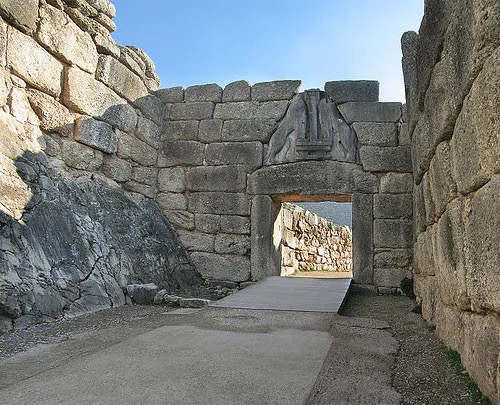What happened?
- The Mycenaean civilization appeared around 1700 BCE and spread throughout most of present-day mainland Greece and many islands. The Mycenaeans developed a sophisticated sociopolitical structure, and they were highly-skilled craftsmen and great engineers.
- The Mycenaean society was organized in states governed by palaces. The palaces functioned as administrative and economic centers and served as a residence for ruling groups. The most prominent was the palace of Mycenae (image below), after which this civilization was named.
- Many important Mycenaean palaces were destroyed between 1250 BCE and 1200 BCE. This started the so-called “post-palatial” period in Mycenaean history as the palaces no longer had control over the people in the region.
- Some Mycenaean groups tried to repair and resettle the destroyed palaces, but they were never successful and by 1050 BCE these settlements were not more advanced than the surrounding villages.
- Although the height of Mycenaean society ended, its cultural influence endured. Evidence of Mycenaean material culture can be found from Italy to the Levant, the Eastern Mediterranean region including modern-day Jordan, Israel, Lebanon, and Syria.

Lion’s Gate – the main entrance to the fortified palace or citadel in Mycenae in present-day southern Greece (from World History Encyclopedia, “Mycenaean Civilization” 2019).
How is this related to climate?
- Some researchers believe that the decline of the Mycenaean palatial system was caused by large natural disasters such as earthquakes and volcanic eruptions, evidenced by broken pottery and damaged walls. These disasters would have been devastating and volcanic eruptions could have impacted the climate.
- Others proposed that the decline was more directly related to climate change. Anthropologist and climate scientist Brandon Drake notes that the Mediterranean Sea cooled very quickly before 1190 BCE, causing reduced rainfall in surrounding regions. Drake and other researchers propose that dry periods around this time, combined with external factors, climatic and otherwise, contributed to the decline. Most likely there was not necessarily a long-lasting or particularly severe singular event (such as a drought, for example) that led to the decline of the Mycenaean civilization.
- From examining cave stalagmites on the Peloponnesian peninsula in southern Greece, researchers noted that an arid period followed the destruction of palaces. This could explain why palaces were not rebuilt, as dry conditions would have made it hard for palaces to reassert their power. Likely, climate change was a contributing factor, but not the only factor, to the decline of this civilization.
- It is important to note that the exact cause of the end of the Mycenaean palatial system is more complicated than any one factor alone. Many interconnected factors including internal and external forces caused it to be more sensitive to climatic changes, leading to its eventual decline.
References and additional resources
- Cartwright, M. “Mycenaean Civilization.” World History Encyclopedia. 2016. https://www.worldhistory.org/Mycenaean_civilization/
- Drake, B. L. “The Influence of Climatic Change on the Late Bronze Age Collapse and the Greek Dark Ages.” Journal of Archaeological Science, vol. 39, no. 6, June 2012, pp. 1862–70. ScienceDirect, https://doi.org/10.1016/j.jas.2012.01.029.
- Finné, M., Holmgren, K., Shen, C. Hu, H. Boyd, M. and Stocker, S. “Late Bronze Age Climate Change and the Destruction of the Mycenaean Palace of Nestor at Pylos.” PLOS ONE, vol. 12, no. 12, Dec. 2017, p. e0189447. PLoS Journals, https://doi.org/10.1371/journal.pone.0189447.
- Hemingway, C. “Mycenaean Civilization.” The Met. Oct. 2003, https://www.metmuseum.org/toah/hd/myce/hd_myce.html.
- Skibba, R. “Did Climate Change Bring Down the Late Bronze Age Civilizations?” Hakai Magazine. 2017. https://hakaimagazine.com/news/did-climate-change-bring-down-late-bronze-age-civilizations/
- Weiberg, E., and M. Finné. “Resilience and Persistence of Ancient Societies in the Face of Climate Change: A Case Study from Late Bronze Age Peloponnese.” World Archaeology, vol. 50, no. 4, Aug. 2018, pp. 584–602. Taylor and Francis+NEJM, https://doi.org/10.1080/00438243.2018.1515035.
- Wright, H. E. “Climatic Change in Mycenaean Greece.” Antiquity, vol. 42, no. 166, June 1968, pp. 123–27. Cambridge University Press, https://doi.org/10.1017/S0003598X00034116.
